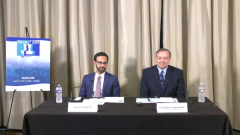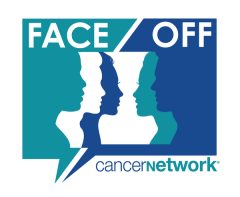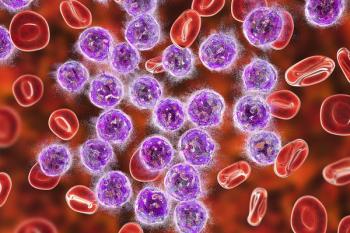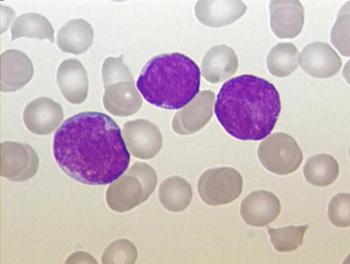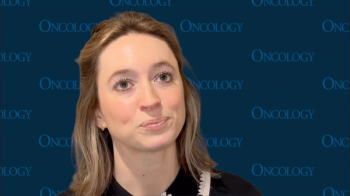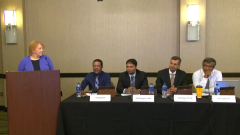
Chronic-Phase CML: The OPTIC Study
Key opinion leader Kebede Begna, MD, reviews data from the OPTIC study focused on ponatinib dosing in chronic-phase CML.
Episodes in this series

Transcript:
Judy Schreiber, PhD, RN: We’re going to switch gears a bit and head into the world of leukemia. Our first presentation is going to be from Dr Begna on third-line therapy in chronic-phase CML [chronic myeloid leukemia]. We’re going to alternate here between Dr Begna and Dr. Mangaonkar in the next 4 presentations, so let’s start.
Kebede Begna, MD: Thank you, Judy. I’ll try to review how we ended up here today talking about ponatinib. As all of you know, the goal of treatment in 2023 is treatment-free remission or operational cure. We ended up starting from the approval of imatinib after [the] IRIS trial in 2001 and back-to-back approval of nilotinib and dasatinib as second-line therapy in 2006 and 2007, and as a first-line therapy in 2010, both at the same time. And as [you know] bosutinib was approved in 2012, first as a second-line treatment for CML and the second line in 2017. Around the same time, ponatinib was found to be very effective, especially in T315I expressed in CML, and they tried to put [it] as a first-line [therapy].There was a comparisons between imatinib and ponatinib, as most of you know,in the EPIC trial.
That trial is the one that shed light on the adverse effect of ponatinib. Ponatinib was approved as second-line [therapy], but it had to be taken out of the market in 2012, except for patients with a T315I mutation. Then that was followed by [the] OPTIC trial, which also helped us to put ponatinib in the third line. Recently, last year, asciminib, as another TKI [tyrosine kinase inhibitor] acting on a different site, led to the approval in the third line. So as third-line [therapies], we have 2, ponatinib and asciminib.
But especially in those patients who are resistant to ponatinib and asciminib, there is an ongoing clinical trial all over the nation led by MD Anderson [Cancer Center],and this medication … it is another TKI inhibitor approved already in China, and there are clinical trials going on here at different sites in the nation. As I said earlier, ponatinib has a complex approval history. It was first approved as a second-line [therapy] based on the original PACE trial in 2012, and the first-line trial was started around the same time. But that trial shed light on the toxic adverse effect of ponatinib, mainly vascular incidents with thrombosis, coronary artery disease. And after discussing with the FDA, the manufacturer pulled their request to put ponatinib in the first line. They conducted the OPTIC or open-label phase 2 trial, and we are going to discuss it today.
The OPTIC trial is with patients with relapsed, TKI-resistant or intolerant chronic phase CML, and they were randomized based on age and other vascular events, including hypertension, diabetes, and hypercholesterolemia. This time there were multiple exclusion criteria. They learned from the phase 1 EPIC trial, and also during that time it was noticed that the original approved dose was 45 mg, and there were some hints that the dose may matter.So they randomized patients to 45-, 30-, and 15-mg[doses], with an intention to decrease the dose based on achieving the primary end point. The primary end point was achieving MR2 [molecular response with 2-log reduction] or a fusion protein BCR level less than 1%. They were checking the level every 3 months and also at the end of the year [using a] bone marrow biopsy for karyotyping. As you see here, the MR2 level was higher for those who were started on ponatinib at 40 mg…24%. The second end point was progression-free survival, overall survival, and assessment of safety. This is the main paper [from] Dr[Jorge] Cortez, [MD,]…and others, and has contributed a lot to our success. Patients with CML are benefiting.
This trial includes, as I said, at the beginning[patients who started on] 45 mg dropped to 15 mg when they achieved the primary end point, 30 mg dropped to 15 mg, and the third group, cohort C, included patients who were taking only 15 mg. For comparison, the PACE trial, the numbers are reasonable, and most of the patients in the OPTIC trial had resistance to all TKIs [to which]the patients were exposed. All of them received at least 2or more, and most of the studies were done outside North America. As you see there, 41 patients In the PACE trial were in the United States.[In the OPTIC trial,] only 9patients were in the United States because we are scared of touching ponatinib to give our patients, especially if you see one patient with this adverse effect, you don’t want to try it again. These are the exclusion criteria, as you see here in the OPTIC trial only 1% of patients had a history of ischemic disease, only 5% with a history of diabetes, and only 5% [of] patients with hypercholesterolemia, in comparison to the original PACE trial, where everybody was maybe included in this trial because they [had thought]that if it is working with T315I-mutated CML, it may be working in all others. That was the rationale for having all those patients with significant comorbidity included in the study.
These are the response rates, as you see those who received a higher dose in comparison to the lower dose almost doubled [the response rate].The primary end point was 51% in the 45-mg arm and only 25% in the 15-mg arm. This applies to all other mutated types. If you see the T315Imutation, the response rate is almost 6times [higher] when you start them on 45 mg than on 15 mg. The beauty is, I classify this paper [as] the one with induction treatment followed by maintenance. If you see the maintenance dose at 12 months, all of them, especially the ones who received 45 mg, were taking 15 mg, and even after 6months, the dose was reduced to 35 mg in some of them. It is the average dose, because if you achieved a primary end point of less than 1% BCR level, then automatically your dose will be reduced to 15 mg at any point in time because they were checking every 3 months. If you achieved a BCR level of less than 1% by 3months, [the dose would] automatically be switched to 15 mg. This avoids the toxicity, but [for] the progression-free survival, there was no significant difference whether you started [at] 45, 30, or 15 mg.
The main point is how to avoid those toxicities. As you see here all of them have some degree of toxicity. We know [that] patients with CML, when you start them [on] TKIs, cytopenias area very common complication. We ask our patients to tolerate some degree of anemia, some degree of thrombocytopenia, because you know that if they achieve treatment-free remission,[not] all of them may end up requiring a TKI. If you see on the curve on the bar graph on the right hand of this slide, the toxicity is almost 3times in the higher dose than in the lower dose. Again, the efficacy is much better if you start with a higher dose.
The take home point is that ponatinib induction at a high dose, followed by maintenance at a low dose, 15 mg, is very reasonable, and the primary end point was easily achieved. But we have to be very careful whenever we are treating a patient above the age of 65. As you see, the MR2 achievement was lower in people above the age of 65. It was only 29% in comparison to 45% in those who are younger than 65. The occlusive events were also higher in the older group, 38% in comparison to only 8%. Dose reduction is recommended as soon as the patient achieves reasonable disease control. What we are hoping is we may have long-term results from this trial. As most of you know, the IRIS trial, every trial is updated every 5years, every 10 years, so when we have the 5-year follow-up, we might have more comfort in treating patients with ponatinib as third-line [therapy]. Thank you.
Transcript edited for clarity.
Newsletter
Stay up to date on recent advances in the multidisciplinary approach to cancer.


